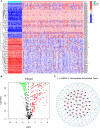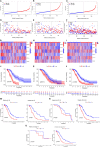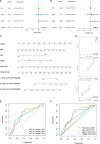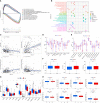Necroptosis-associated long noncoding RNAs can predict prognosis and differentiate between cold and hot tumors in ovarian cancer
- PMID: 35965557
- PMCID: PMC9366220
- DOI: 10.3389/fonc.2022.967207
Necroptosis-associated long noncoding RNAs can predict prognosis and differentiate between cold and hot tumors in ovarian cancer
Abstract
Objective: The mortality rate of ovarian cancer (OC) is the highest among all gynecologic cancers. To predict the prognosis and the efficacy of immunotherapy, we identified new biomarkers.
Methods: The Cancer Genome Atlas (TCGA) and the Genotype-Tissue Expression Project (GTEx) databases were used to extract ovarian cancer transcriptomes. By performing the co-expression analysis, we identified necroptosis-associated long noncoding RNAs (lncRNAs). We used the least absolute shrinkage and selection operator (LASSO) to build the risk model. The qRT-PCR assay was conducted to confirm the differential expression of lncRNAs in the ovarian cancer cell line SK-OV-3. Gene Set Enrichment Analysis, Kaplan-Meier analysis, and the nomogram were used to determine the lncRNAs model. Additionally, the risk model was estimated to evaluate the efficacy of immunotherapy and chemotherapy. We classified necroptosis-associated IncRNAs into two clusters to distinguish between cold and hot tumors.
Results: The model was constructed using six necroptosis-associated lncRNAs. The calibration plots from the model showed good consistency with the prognostic predictions. The overall survival of one, three, and five-year areas under the ROC curve (AUC) was 0.691, 0.678, and 0.691, respectively. There were significant differences in the IC50 between the risk groups, which could serve as a guide to systemic treatment. The results of the qRT-PCR assay showed that AL928654.1, AL133371.2, AC007991.4, and LINC00996 were significantly higher in the SK-OV-3 cell line than in the Iose-80 cell line (P < 0.05). The clusters could be applied to differentiate between cold and hot tumors more accurately and assist in accurate mediation. Cluster 2 was more vulnerable to immunotherapies and was identified as the hot tumor.
Conclusion: Necroptosis-associated lncRNAs are reliable predictors of prognosis and can provide a treatment strategy by screening for hot tumors.
Keywords: TCGA; immunotherapy; long noncoding RNAs; necroptosis; ovarian cancer.
Copyright © 2022 He, Fang, Hu, Chen, Shen, Chen, Mu, Li, Zhang, Yong-lin and Zhang.
Conflict of interest statement
The authors declare that the research was conducted in the absence of any commercial or financial relationships that could be construed as a potential conflict of interest.
Figures









Similar articles
-
Predicting Prognosis and Distinguishing Cold and Hot Tumors in Bladder Urothelial Carcinoma Based on Necroptosis-Associated lncRNAs.Front Immunol. 2022 Jul 4;13:916800. doi: 10.3389/fimmu.2022.916800. eCollection 2022. Front Immunol. 2022. PMID: 35860239 Free PMC article.
-
Necroptosis-Related lncRNAs: Predicting Prognosis and the Distinction between the Cold and Hot Tumors in Gastric Cancer.J Oncol. 2021 Nov 8;2021:6718443. doi: 10.1155/2021/6718443. eCollection 2021. J Oncol. 2021. PMID: 34790235 Free PMC article.
-
A five necroptosis-related lncRNA signature predicts the prognosis of bladder cancer and identifies hot or cold tumors.Medicine (Baltimore). 2023 Oct 13;102(41):e35196. doi: 10.1097/MD.0000000000035196. Medicine (Baltimore). 2023. PMID: 37832111 Free PMC article.
-
Necrosis-Related lncRNAs: Biomarker Screening and Prognostic Prediction for Hot and Cold Tumours of Prostate Cancer.Arch Esp Urol. 2024 Nov;77(9):1078-1088. doi: 10.56434/j.arch.esp.urol.20247709.151. Arch Esp Urol. 2024. PMID: 39632531
-
Integrated analysis of necroptosis-related lncRNAs for prognosis and immunotherapy of patients with pancreatic adenocarcinoma.Front Genet. 2022 Aug 16;13:940794. doi: 10.3389/fgene.2022.940794. eCollection 2022. Front Genet. 2022. PMID: 36051690 Free PMC article.
Cited by
-
Exploring Unique Extracellular Vesicles Associated Signatures: Prognostic Insights, Immune Microenvironment Dynamics, and Therapeutic Responses in Pancreatic Adenocarcinoma.Mediators Inflamm. 2024 Aug 24;2024:2825971. doi: 10.1155/2024/2825971. eCollection 2024. Mediators Inflamm. 2024. PMID: 39220187 Free PMC article.
-
LncRNAs and regulated cell death in tumor cells.Front Oncol. 2023 May 29;13:1170336. doi: 10.3389/fonc.2023.1170336. eCollection 2023. Front Oncol. 2023. PMID: 37313458 Free PMC article. Review.
-
Predicting survival in bladder cancer with a novel apoptotic gene-related prognostic model.Discov Oncol. 2024 Nov 24;15(1):702. doi: 10.1007/s12672-024-01575-z. Discov Oncol. 2024. PMID: 39580765 Free PMC article.
-
The role of pyroptosis-related lncRNA risk signature in ovarian cancer prognosis and immune system.Discov Oncol. 2023 Aug 19;14(1):149. doi: 10.1007/s12672-023-00767-3. Discov Oncol. 2023. PMID: 37597098 Free PMC article.
-
Histone acetylation-related IncRNA: Potential biomarkers for predicting prognosis and immune response in lung adenocarcinoma, and distinguishing hot and cold tumours.Front Immunol. 2023 Mar 17;14:1139599. doi: 10.3389/fimmu.2023.1139599. eCollection 2023. Front Immunol. 2023. PMID: 37006256 Free PMC article.
References
LinkOut - more resources
Full Text Sources

